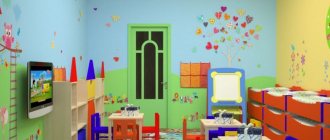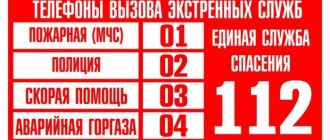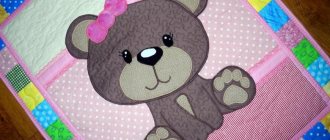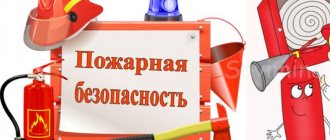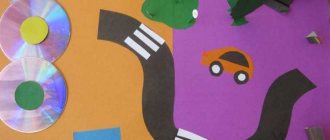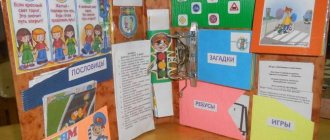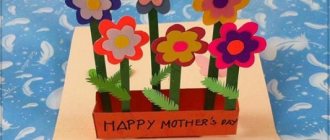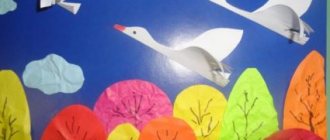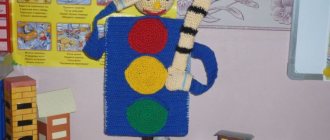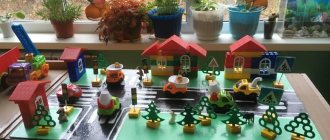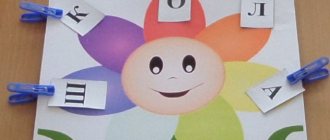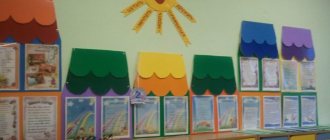Every interested parent goes through the experience of decorating children's themed corners with their own hands. The pets themselves and teachers participate in the creation of this mandatory element of the interior in preschool and school institutions.
The items that make up the composition can be crafts made during classes or specially selected items (souvenirs, printed materials) that have developmental significance.
In kindergarten and elementary grades, parents can also be involved in equipping the corners. Their indirect participation is also implied at subsequent stages of study, when students, having received an appropriate creative task, turn to family members for help.
Interior features in kindergarten
Decorating rooms for games and activities allows you to zoning the space and optimally use visual attributes in the process of raising and developing a child.
In addition to permanent corners with toys, construction sets and materials for manual labor, stands and shelves with children’s work are organized, which are periodically updated.
Thematic exhibitions with crafts and drawings complement the theme of the matinees; they can change in accordance with the seasons and holiday dates.
To create an exhibition board for drawings, the most suitable material is considered to be a lightweight cork sheet on which the paper can be fixed using buttons. It can be rectangular or with a curly cut.
The cork board is installed on a wooden, plastic or aluminum frame, which is firmly fixed to the wall. The surface of the stand can be painted or decorated with figures made of self-adhesive paper.
To create a display board, the content of which is updated daily, you can use a frame with stretched fabric, while the drawings are secured with safety pins.
Making your own passe-partout and special pockets for paper is an integral part of decorating corners in kindergarten.
The ability to abandon buttons and other metal fasteners will protect children and they will be able to change exhibits on their own.
To place bulky crafts, it is convenient to use narrow wall shelves. You can creatively add images of fairy-tale characters in poses supporting stands for figurines made by children into the background of the design.
Socotra
One of the few places not spoiled by civilization. The archipelago is located in the Arabian Sea, territorially belongs to Yemen and includes the islands of Darsa, Abd al-Kuri, Socotra and Samha. The largest island in area is Socotra - 3625 sq. km. It was he who gave the name to the entire archipelago. In addition, Socotra is a real paradise for researchers and fans of unique flora and fauna. At least 30% of all plants growing on the archipelago and more than 90% of the representatives of cold-blooded reptiles living on it are found only within its borders. And nowhere else on the planet. This became possible due to the isolated position of the island ecosystem, which was formed over 20 million years.
Our planet is unique and multifaceted. And all the secret corners of nature have not yet been identified. But we hope that we managed to convince you of this. And perhaps inspire some of the readers to go on an exciting journey towards the incredible.
Text:
A corner to connect with nature
The concept of decorating a corner of nature with your own hands depends on the age group and the ability to regularly care for the exhibits.
You can create a model of a farm or savannah with plastic figures. Nearby you can place cards with images of animals, insects and plants.
For children who can take part in watering and care, you can create a picturesque corner with climbing and exotic plants.
Nearby on the windowsill you can set up an indoor vegetable garden for germinating seeds.
As additional attributes, you can use temperature and humidity sensors, spray bottles and water containers, special cloths for cleaning plants, and spatulas for loosening.
You can use tree bark, pine cones, and herbariums to decorate the corner. In the common playroom, if regular specialized care is possible, you can also place an aquarium with fish.
In addition, in a corner of nature in each group it is necessary to have:
- Natural vegetables and fruits, or their dummies.
- Sets of pictures depicting animals, birds, insects and more.
- Albums "Seasons"; books with illustrations depicting animals; paintings by famous artists.
- Children's drawings about nature and crafts made from natural materials.
- Material for labor. Aprons, watering cans, spatulas, loosening sticks, and rags are useful for caring for indoor plants. Brooms and dustpans - to maintain cleanliness in a corner of nature and a group.
- Equipment for experiments. Molds, funnels, shovels, sieves will be needed for playing with sand. To play with water, you can use pipettes, disposable syringes, and containers of various shapes. To make crafts, you need natural and waste materials (shells, pebbles, pine cones, acorns, chestnuts, twigs). For children in the preparatory group, working with a magnifying glass, microscope, and scales will be interesting.
- Didactic games with natural content “Who eats what?”, “Whose house?”, “Whose baby?” and others.
Filling the corner of nature with the necessary material will depend on the age of the children and the requirements of the Education Program.
A corner of nature is necessary not only for observations. It also contributes to the formation of labor skills. Already from the younger group, children are involved in carrying out individual work assignments. And from the senior group, duty in a corner of nature is introduced.
Rack for sports equipment
Decorating a sports corner with your own hands is done in the active games area. For bright hoops, clubs, balls and jumping ropes, it is necessary to organize aesthetic and convenient storage with special holders, nets and shelves.
To equip the corner, you need to use the safest plastic or fabric products.
The contents of the exhibition can be supplemented with homemade items, such as fake fishing rods or other devices for developing dexterity.
Information board in children's institutions
When decorating a corner for parents with your own hands, the overall aesthetics of the institution are preserved.
The composition, as a rule, is placed in the reception area, the most optimal place is above the changing lockers or at the entrance to the room. A section of the wall is decorated with bright, cheerful drawings or wall relief figures, the details of which can be supplemented with seasonal or festive elements.
Contents of a corner of nature
The content of the subject-developmental environment for the environmental education of children is distributed between two zones:
- pets' corner;
- experimentation zone.
Living corner: plants
In order for children to be able to draw conclusions during observations regarding the characteristics of plant growth and development, the flora of the nature center must be selected and maintained within the framework of certain rules.
Requirements
- To become familiar with the characteristics, conditions and lifestyle of plants, they should be typical for a group of indoor plants. In other words, flowers blooming beautifully in the front garden will not take root on the windowsill, so you should not break the usual order of things and put them in pots. It’s better to take the kids out into the yard and show them certain features of flower growth in natural conditions.
- Indoor plants should be bright, attracting the attention of preschool children, who at 1.5–3 years old, for example, rarely concentrate on one object for more than 5–7 minutes.
- Each flower must be presented in at least two copies. This is especially important in the second younger group, where children learn to identify not only general, but also individual features of this or that representative of the flora.
- The flowers are selected to be unpretentious, since the teacher does not have the physical ability to combine caring for capricious plants and the educational process, and children 1.5–4 years old are still too young to take full responsibility for caring for green pets.
- Plants must be selected for the conditions (temperature, humidity level) in which they will be located. For example, geraniums and cacti need light, but begonias and violets, on the contrary, love shade.
- Plants should be pleasing to the eye, so it is important to choose a harmonious combination of colors and design of pots.
- All facilities must be accessible for observation and care for children.
- For full growth, each plant needs to choose the right soil composition. At the same time, substances for feeding and processing flowers should be out of the reach of children.
- There should not be temperature changes in the room - the flowers may dry out or lose their leaves, and you should not place plants near the entrance or ventilation - drafts will destroy the flowers.
Which plants to choose
As practice shows, the most optimal choice for taking into account all the requirements will be representatives of the three groups of indoor flowers.
- Tropical plants: vines, orchids, epiphytes. For kids, these flowers are interesting because they do not have a dormant period, that is, their growth can be observed constantly.
- Subtropical plants: aspidistra, saintpaulia, which have dormant periods. Very convenient in rooms located on the ground floor, which means, one way or another, subject to temperature changes. Therefore, representatives of the subtropics are especially in demand in the first younger group, since children of this age are usually “housed” below.
- Desert inhabitants: cacti, succulents - lovers of heat and light. That is, the threat of “forgot to water” is not scary for them. In addition, the funny appearance of these plants attracts kids.
Experimentation zone
This part of the subject-development environment is intended for the empirical study of living and inanimate nature. Usually placed in boxes or crates. For children 1.5–3 years old, the experimentation zone is presented in a very condensed form, since children do not do experiments to the extent that this type of work is practiced in the middle and older groups. In the second youngest there is a slight replenishment of materials, but in general the equipment remains unchanged.
- Dishes. Cups, funnels, plates, strainers and trays. These items are needed, for example, to get acquainted with the properties of water (take the shape of the body in which it is placed) in the second junior group. In the first younger group, dishes serve as attributes for playing with dolls.
- Natural materials: sand, shells, pine cones, chestnuts, pebbles - are used to create crafts and get acquainted with the concept of shape and size. The same box may contain waste material: threads, pieces of cardboard, colored paper for creative activities.
- Materials distributed in blocks (in boxes). For example, balloons, soap bubbles, pinwheels for learning the concept of “air”, colored pebbles for learning colors, empty Kinder Surprise boxes with different fillings (cereals, sugar, coins, etc.) for getting acquainted with various sounds and measures of weight ( hard - easy), sachet bags with lavender, chamomile for working with the concept of smell, a mirror for playing with a sunbeam when considering the concept of light.
- Collections of sea pebbles and shells. In principle, this is an optional item, since these materials are in the natural materials section.
- Nature calendar (from the second younger group). This model for observing seasonal and weather changes is presented in a simplified form. For example, in the form of a poster with pockets for placing the sun, clouds, clouds to demonstrate the current weather, as well as pictures with a snowflake, a flowering meadow, colorful foliage and trees with buds to indicate the season.
- A doll dressed in seasonal clothing to give children an idea of how to dress in different weather and seasons.
- Visual material in the form of books or cards with large images of insects, birds, wild and domestic animals, garden crops. In addition, the block of visual materials may contain cards showing the work of adults for the benefit of nature, as well as audio recordings of the sounds of nature (the sound of the sea, rain, rustling leaves, sounds made by animals, etc.).
- Didactic material for games (3-dimensional figurines of local, exotic and marine animals, soft dummies of vegetables and fruits, sewn from felt).
- Materials for work activities. The minimum available at preschool age is represented by watering cans, rags to wipe up spilled water, oilcloths if flowers need to be rearranged before watering.
- Seasonal objects: in summer - bouquets of flowers, in autumn - bouquets of autumn leaves, in winter - spruce branches in vases, in spring - flowering branches of trees and shrubs.
Subject developmental compositions in kindergartens
Exhibits with special paraphernalia on traffic rules, hygiene and healthy eating, shelves with musical instruments, books or pencils are also located in separate areas with a thematic design.
According to the requirements of modern pedagogy, privacy zones can also be created in playrooms and classrooms - houses, tents, curtained areas with upholstered furniture.
In the process of decorating corners with your own hands, you can use photo collections with successful solutions.
